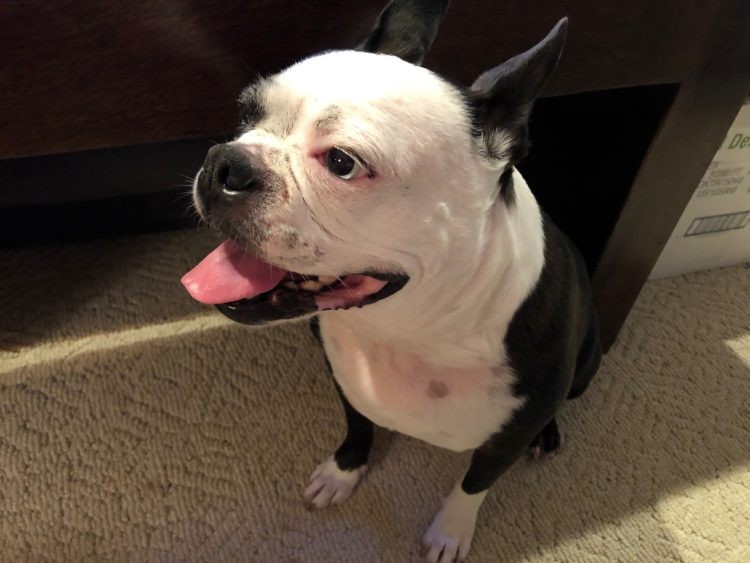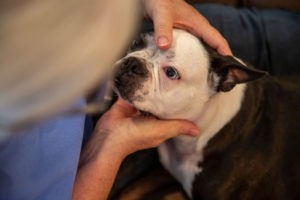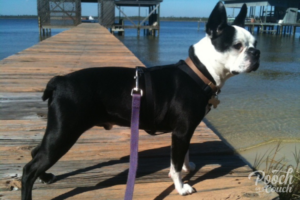Summer is in full swing. Here in the deep south, hot summer days mean pop-up thunderstorms. Some days there will be a storm, and somedays there won’t, but storms are almost always in the daily forecast. The best the weather forecasters can do is say “maybe” your immediate area will get a quick thunder-boomer or downpour. If your dog has storm phobia, you know there is nothing “quick” about a pop-up storm.
Summer storms make storm phobia management hard. Or harder, especially if medications or calming supplements need to be given as part of an overall behavioral treatment/management plan. Almost always, meds or supplements need to be given 45 minutes to an hour before stormy weather arrives. If I dose based on the daily forecast, Dogs ends up getting meds they don’t need if a storm doesn’t develop. I worry about that.
Sassy Blue, my foster dog has storm phobia. She and I have been working with her anxieties since she arrived back with me on May 31, 2019. I decided it was time to give you an update on her progress and how our storm phobia behavioral plan has evolved.
Sassy’s Storm Phobia
Managing Your Dog’s Storm Phobia
Sassy Blue’s Storm Phobia Progress Report
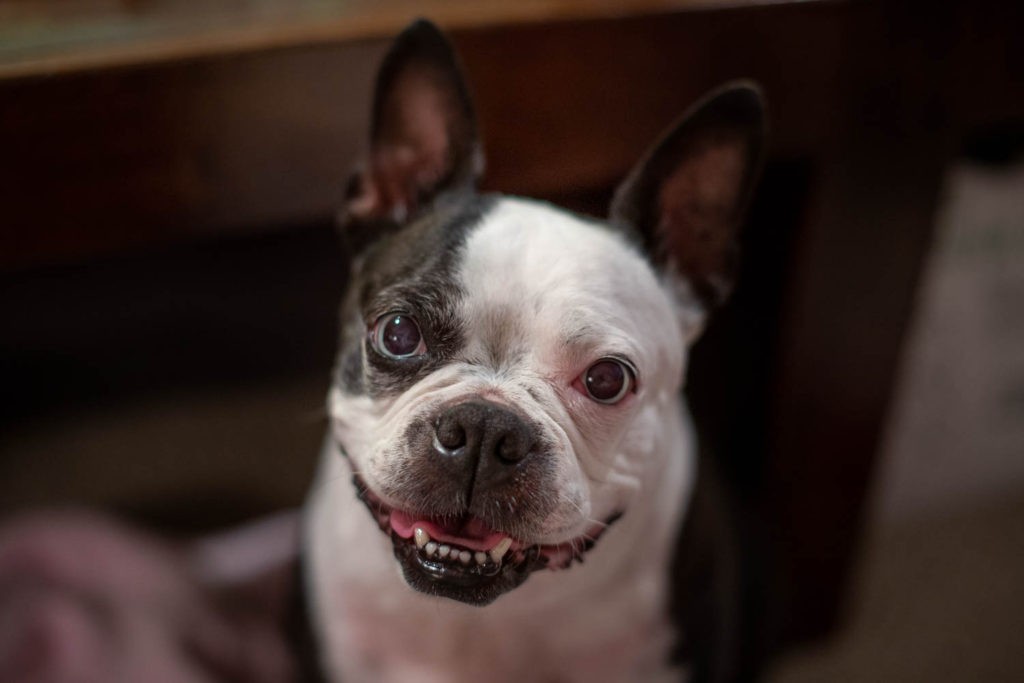
To review, these were Sassy’s storm triggers at the height of her storm phobia:
- rapidly darkening skies
- blustery wind
- steady rain
- drop in barometric pressure
- distant thunder
- lightning
Any single trigger would cause her to immediately begin pacing, panting and trembling, and her eyes would fully dilate. Her fear responses happened so quickly! My attempts to get her attention or provide her with comfort were met with resistance.
She didn’t want to be held, comforted, or touched. Nor did she want to be up on the sofa or the bed, preferring instead to be on the floor. She refused her most favorite treats. All I could do was watch her pace and pant and tremble.
When storms blew up in the middle of the night, she’d wake me up by pawing the mattress while panting in my face. I would put her up on the bed and she would jump right down. Even at night, she didn’t want to be comforted they way I thought I should comfort her. To me, it seemed she just wanted me awake and with her. She didn’t want to be alone while she paced and panted.
After storm would pass, Sassy was exhausted. She would sleep for hours and hours, and wasn’t interested in playing with Otis or her toys. Often, she’d crawl into her crate and sleep.
It is pitiful to watch a dog with storm phobia be visibly anxious and afraid and reject your offers for comfort. I’ve never felt more helpless in my life!
If Your Dog Has Storm Phobia, Research to Learn Best Practices
I did a lot of reading and research on storm phobia and I collected all of the tools I might need to help Sassy feel less fearful during storms and (maybe) help her recover from storm phobia. I also had an in-depth conversation with my veterinarian.
I Selected These Tools to Help Sassy With Her Storm Phobia
- The local weather forecast
- A Thundershirt
- Calming music, such as “Through a Dog’s Ear”
- A big box fan that made significant noise
- A quiet room – I chose an interior closet and set up a small dog bed there.
- Coverings for the windows – If I could have afforded black-out shades, I would have purchased those. I selected dark moving blankets instead.
- “Storm Stress” homeopathic drops, as needed
- Trazodone, prescribed as needed
- Prozac, low-dose, prescribed daily – Sassy was already taking this medication for some different behaviors, but it is also used sometimes for other anxiety issues, so I include it in my “toolbox.”
- Counter-conditioning exercises
- More knowledge on massage and pressure points
- Her most-favorite treats
- Me – Everything I read about helping a dog that has storm phobia said the same thing: I must be calm, confident, prepared, and timely with my interventions.
How I Help Sassy With Her Storm Phobia
I Check The Weather Predictions Every Day
I watched the local news twice a day. I have a weather app on my phone.
I promise you this: There is nothing more unpredictable than predicting the weather! It could be quite frustrating because if I chose to use medications, I would need to dose her 45 minutes to an hour before her storm triggers arrived. If the storms broke apart (typical in the city of Atlanta) I would have dosed her for nothing, and she’d spend the day sleeping.
I wondered to myself if errantly dosing her could end up making medications ineffective. Inevitably, I would miss, and Sassy would have to endure weather without any help from sedatives or calming agents. I knew it would make recovery slow: when a dog has storm phobia, the goal is to prevent them from reaching a full-blown panic state during a storm. Yeah. It’s a goal I often didn’t reach.
I Use Noise To Our Advantage
Noise became a first line, go-to strategy. TV, music, box fans provided a competing source of sound that, at least when the thunder was distant, could sometimes mask the sounds of storms. It also helped to muffle the sound of rain.
Nighttime weather was particularly hard.
Last summer, after a week of middle-of-the-night pop-up thunderstorms, I, exhausted, plugged in the box fan and placed it in a strategic location in the bedroom, near (but not too close) to Sassy’s dog bed. I was hopeful that the fan would drown out the noise of distant thunder and/or rain and I (and Sassy) could get more consistent sleep. This became our nightly routine. Sometimes it worked, most of the time it didn’t.
Often, I’d close the blinds and doors so Sassy couldn’t see the rain.
Sassy wore her Thundershirt most days. I reserved her chemical agents for when the forecast called for weather that was more prolonged than summer pop-up storms.
I Used Sassy’s Coping Skills – Pacing.
Early on, pacing helped her the most, I think. She seemed to want me mobile, too, and during the daytime it was easy enough to accommodate her. So, during stormy weather, I’d do house chores like tidying up or dusting – chores that had me on the move. I avoided chores like vacuuming or folding clothes – for some reason, Sassy has always been leery of anyone “popping” towels or tee-shirts.
All the while, I’d look down at her and acknowledge the weather, calmly and confidently tell her that it would be over soon and that she is OK. Sometimes, I’d give her a firm rub-down.
If I stopped for a moment or sat down, she came to me, stood on her back legs while her front legs rested against my leg. Eyes glazed and dilated, tongue hanging out, mouth frothy from panting and excessive salivation.
It was (and is) hard to watch.
For a while, she even got worse. Any rain became a trigger. So did any type of wind. She seemed to be over-generalizing these weather conditions and I worried that I wouldn’t be able to help her learn new coping skills, or worse — she’d over-generalize to other noises like fireworks (which thankfully, she doesn’t react to that noise.)
Counter-Conditioning Is A Way to Change Storm Fears Into Joys
We tried counter-conditioning exercises. Counter-conditioning is a technique where you, by optimal timing and the best-treats-on-the-planet, slowly change a dog’s associations to a stimulus. For Sassy, this meant that every time her triggers occurred, I was present with her favorite (and fishy!) treats. Gust of wind? Here are treats. Sound of thunder? More treats! Over time, when CC is done correctly, a dog will learn to anticipate good things during storms, and the fear is extinguished.
Early on, Sassy was unresponsive to my training techniques, already in full-fear mode with dilated eyes, trembling, panting and a glazed look in her eye. She “checked out” so quickly after she experience her first trigger, I was unable to use CC.
These days, sometimes she’ll be interested in treats during storms, sometimes she won’t.
Taking Care To Not Reinforce The Wrong Behavior
One of her behaviors seemed to have been conditioned, learned or at least, made worse.
Trembling.
I noticed that often, Sassy would tremble only when I spoke to her. She could pant and pace, but when I said something to her, like – “It will be over soon” or, “You are OK.” She would tremble with more purpose. If I looked at her, she would tremble harder. Or, she might not be trembling at all, and if I interacted with her, she would begin to tremble.
While the dog experts are split on whether or or not you can reinforce fear, I’m sure they all agree that you can reinforce a fear behavior – you can condition a dog to act afraid.
It seemed to me that Sassy’s trembling behavior had accidentally been rewarded. The challenge would be to acknowledge that her trembling was indeed a manifestation of her panic while at the same time observe when and why it became more intense. I do not want to reward her for behaviors that she displays while in a panic state. I want to do what I can to reduce her panic state.
It’s a dance.
Sassy Blue, Then and Now: Her Storm Phobia Has Improved
Looking back, Sassy’s storm phobia behaviors were so much worse than they are today. We’ve easily experienced one hundred storms/rain showers this past year. She still has storm phobia, but recently, she has decided to use some coping skills and in some ways, during some storms, she is able to direct herself to calming behaviors and places. This is a huge step for her.
- Sometimes, Sassy remains calm during gentle rain showers. This is a wonderful improvement, as for a while there, she couldn’t ignore any raindrops and I feared her phobia was worsening. It does help when I close the blinds and use noise to cover up the sound of rain, but I do notice that sometimes if she sees the rain, she doesn’t become stressed.
- Sassy has learned (or I’m more observant!) to let me know when she feels the barometric pressure changing. She is now able to do this without being in a full-blown panting, pacing panic. I’m able to more timely manage her immediate environment. In return, when the storms do come, she pants and paces less, and after the storms pass, her recovery is so much quicker.
- Sassy now uses her quiet room (or creates her own) for comfort. She most often needs me to walk her to her quiet room, but when there, she settles herself in her bed and calms herself down. If I had to guess, I’d say she uses her quiet room about 20% of the time, and mostly during nighttime storms. This, I think, is a huge improvement.
- When I choose to give her medicine or supplements, they work better. It takes a while to learn the right dosage and honestly, it takes a while to learn when to to use them or when to skip them all together.
- She paces less.
- Sometimes I can get Sassy to participate in counter-conditioning exercises, sometimes she’s not receptive. I’ve chosen one trigger to work on: soft rain showers. If I chose to work on all of her triggers using CC, I think I’d overwhelm her.
- Sassy’s overall stress issues are greatly reduced, and I know this affects her response to storms. A year ago, not only was Sassy having fear issues with weather, her allergies were completely out of control, she was still adjusting to a major life change (adoption return) and I was having difficulty getting her to eat. These days, her allergies are well-managed, her appetite is back to normal, and she’s recovered from three (!) different surgeries.

If Your Dog Has Storm Phobia, There Is Hope.
Recovery from storm phobia (or any other behavioral issue for that matter) is never a straight line. Fear, anxiety, and phobia behaviors manifest in intensity based on so many factors. The barometric pressure never rises and falls at the same rate or to the same level. The rain never falls the same way twice. Wind is always different. So is thunder, lightning. Our dog that has storm phobia is also possibly in a different state of mind each tine a storm brews. The formula is never the same.
The same is true with those of us that manage our own stressor or illnesses. Some days are good, some days are awesome, other days are not the best. Some days it feels like starting over.
For Sassy and I, I truly believe the work done developing our relationship influences her recovery from storm phobia more than all of my management tools put together. Sassy truly is terrified, irrationally so, that she is in danger during storms. I try and fight the urge to overly-console her while doing what I can to comfort her. Doing so, I believe, helped her trust me, which translates to more confidence in her when she makes a choice that makes herself feel better. I’m beginning to see her make those choices and I’m really proud of her. I have hope and I know there’s hope for you and your dog!
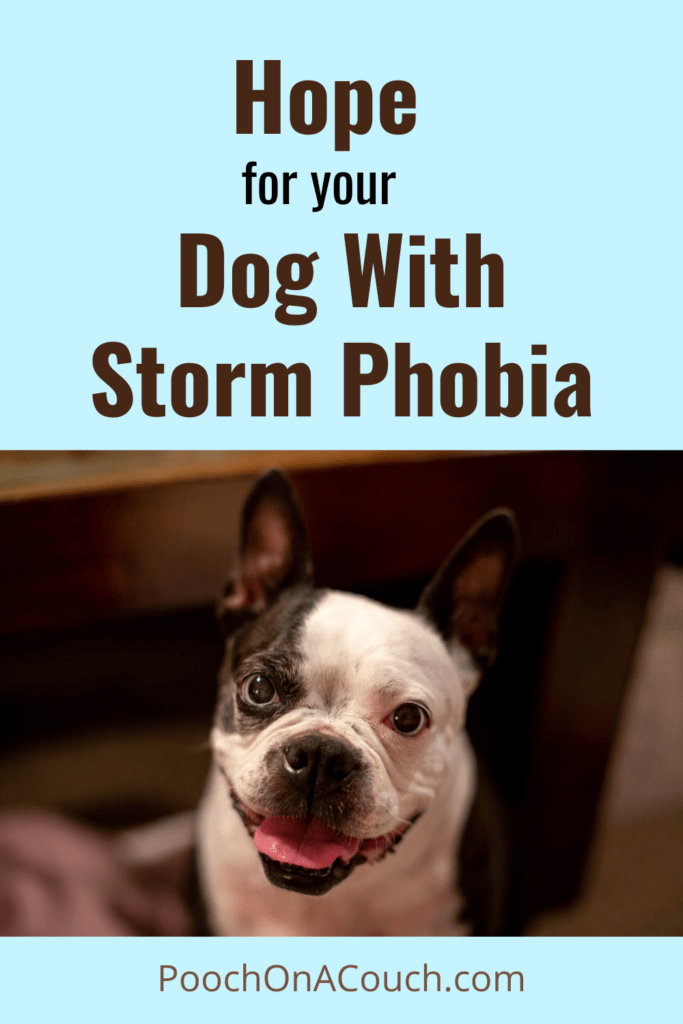
More Reading On Storm Phobia
Reinforcing Fear and Thunder Phobia
Thunderstorm Phobia In Dogs (.pdf)
Noise and Storm Phobias And Anxiety In Dogs

